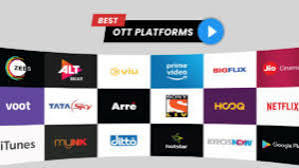Film Industry: Bollywood and OTT Platforms


The Indian film industry, primarily known as Bollywood, has long been a dominant force in global cinema, captivating audiences with its vibrant storytelling, colorful musicals, and larger-than-life productions. For decades, Bollywood has shaped Indian pop culture, producing hundreds of films annually and contributing significantly to India’s cultural and economic landscape. However, in recent years, the rise of OTT (Over-The-Top) streaming platforms like Netflix, Amazon Prime Video, Disney+ Hotstar, and Zee5 has begun to challenge the traditional Bollywood model, reshaping how films are produced, distributed, and consumed.
Bollywood’s Changing Landscape
Bollywood, once synonymous with grandiose films that often featured song-and-dance routines, is experiencing a shift in both production and content. Directors and producers are increasingly exploring more diverse and realistic storytelling, driven by audience demand for fresh, meaningful narratives. Films like “Andhadhun”, “Dangal”, and “Gully Boy” reflect this transition, blending mainstream appeal with critically acclaimed storytelling. The industry is also beginning to embrace new genres, such as thrillers, biopics, and experimental films, challenging the conventional Bollywood formula.
Despite this, Bollywood still faces challenges, including the growing demand for better-quality content and issues like nepotism, which has led to public disillusionment. The global success of Bollywood films like “RRR” and “Pathaan” has highlighted the growing influence of Indian cinema internationally, but the industry’s future relies heavily on its ability to innovate and evolve with changing audience tastes.
The Rise of OTT Platforms
The emergence of OTT platforms has dramatically shifted how Indian audiences engage with film and television. With the pandemic accelerating the growth of digital streaming, OTT platforms have become the preferred medium for millions of viewers. These platforms offer unparalleled convenience, allowing users to watch content on-demand, with no reliance on cinema showtimes or television broadcasts. As a result, OTT has democratized access to content, with people across various regions of India enjoying films and series in multiple languages, often without the filter of commercialized mainstream media.
OTT platforms have introduced a new wave of Indian content, with series like “Sacred Games”, “Mirzapur”, and “The Family Man” achieving widespread popularity. These shows delve into complex narratives, mature themes, and high production values that traditional Bollywood films often avoid. They’ve attracted a more diverse audience—ranging from urban youth to global viewers—and have given rise to a new generation of actors and filmmakers.
Bollywood vs. OTT: The Tension and Synergy
While OTT platforms are rapidly gaining market share, Bollywood is not being left behind. Many Bollywood films are now being released directly on streaming services, bypassing traditional theatrical releases. This shift has brought both opportunities and challenges. On one hand, OTT has provided a much-needed lifeline for films struggling to get theatrical distribution, especially during the COVID-19 pandemic. On the other hand, it has raised concerns about the sustainability of cinema halls and the traditional movie-watching experience.
However, rather than being a direct competitor, OTT has increasingly become a partner for Bollywood. Major film studios and production houses are now creating exclusive content for OTT platforms, sometimes even releasing films directly on streaming services rather than in theaters. The collaboration between Bollywood and OTT has created new opportunities for content creators to reach wider, more diverse audiences.
Future Outlook
The future of the Indian film industry is likely to be a hybrid of traditional cinema and OTT platforms. While Bollywood films will continue to draw massive crowds to theaters with big-budget releases and star-studded casts, OTT platforms are expected to remain the go-to destination for diverse, niche, and experimental content. As India’s internet penetration continues to grow, and more people gain access to affordable data plans, the influence of OTT platforms is set to expand, potentially reshaping the way films are made, distributed, and consumed.
In conclusion, the Indian film industry is undergoing a period of significant transformation, driven by the rise of OTT platforms. This shift represents both a challenge and an opportunity for Bollywood, as it navigates an increasingly competitive entertainment landscape. The blending of traditional cinema with digital streaming is creating a more dynamic and accessible film culture in India, one that is embracing both innovation and nostalgia.


DISCLAIMER: The author is solely responsible for the views expressed in this article. The author carries the responsibility for citing and/or licensing of images utilized within the text.
